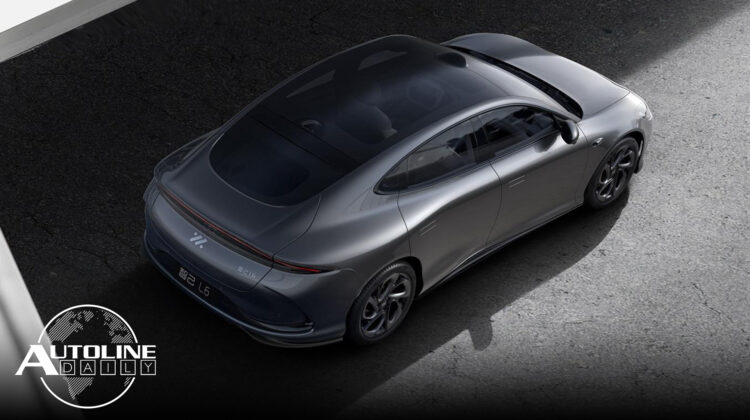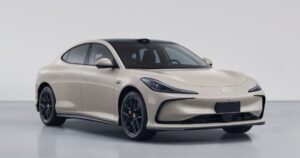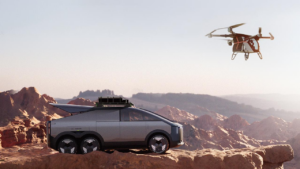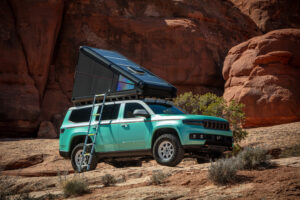

Follow us on social media:
Runtime: 9:33
0:00 China’s IM Motors Claims First Solid State Battery
1:14 CATL To Supply Tesla in Nevada
1:34 EV Battery Warranty Should Be 15 Years
2:26 Nissan Targets Huge Sales, EV Growth
3:51 U.S. Lithium Mining Tied Up in Red Tape
5:22 Xpeng Close to VTOL Certification
6:02 Stellantis Axes 400 U.S. Employees
6:53 Honda To Cut Dealer Profit Margins
7:37 McLaren Now Owned by Bahrain
8:19 Jeep’s Easter Safari Concepts
Visit our sponsor to thank them for their support of Autoline Daily: Bridgestone and Intrepid Control Systems.
This is Autoline Daily, the show dedicated to enthusiasts of the global automotive industry.
CHINA’S IM MOTORS CLAIMS FIRST SOLID STATE BATTERY
Did a Chinese automaker just beat everyone to the market with a true solid state battery? IM Motors claims its upcoming sedan, the L6, will have the world’s first mass-produced, ultra-fast charging solid state battery. It says the 130-kWh battery in the L6 sedan will deliver 1,000 kilometers of range or 620 miles, and even adjusting that to an estimated EPA range, that still comes to 403 miles. IM Motors says this will be a fast charging battery thanks to a nano-scale solid electrolyte coating on ultra-high nickel materials for the positive electrode. And the negative electrode gets a new generation of high-energy-density composite silicon-carbon materials. It will be capable of nearly 900 volts but did not say how fast the battery can charge. It will release more technical details on April 8th. Interestingly, it looks like this was developed in-house, not with a major battery supplier.

CATL TO SUPPLY TESLA IN NEVADA
Speaking of fast charging batteries, CATL’s chairman Robin Zheng, tells Bloomberg that they will start supplying cells to Tesla’s battery plant in Nevada. Even though Tesla is starting to make batteries on its own, it’s still dependent on suppliers like CATL, Panasonic and BYD.
EV BATTERY WARRANTY SHOULD BE 15 YEARS
China, the U.S. and the EU have a mandate that EV batteries have to last for 8 years, but other battery experts say that should be bumped up to 15 years. And they want those batteries to retain 85% of their original capacity, versus the 70% in today’s mandates. JB Straubel, who used to work at Tesla, and now runs the battery recycling company Redwood, says the life cycle of the typical battery pack is already close to 15 years and CATL is working on extending its warranty to 15 years. A study by the company Recurrent, which looks at battery analytics, says the average EV battery only loses 20 miles of range over 8 years, and that outside of big recalls, like for the Chevrolet Bolt and Hyundai Kona, battery replacements are quite rare.
NISSAN TARGETS HUGE SALES, EV GROWTH
Nissan laid out an ambitious new business plan it calls, The Arc. In three years, it wants to sell 1 million more vehicles than it did last year. And last year it sold a little less than 3.4 million vehicles around the world, so it wants to increase its sales by nearly 30% by the end of its 2026 fiscal year. To reach that goal, Nissan says it will launch 30 new models in those three years. 16 of them will be electrified and the other 14 will be ICE. Mostly these are refreshed versions of current models, but it also includes 7 all-new models for the U.S. and Canada some of which will feature plug-in hybrid and Nissan’s E-Power technology, which uses an IC engine as a generator to charge the battery. Just like the system powertrain expert Micky Bly told us Ram would use on last week’s Autoline After Hours. Nissan also plans to increase its operating profit margin to more than 6% by reducing its EV costs. That includes developing EVs in families, so they can share parts and components. It says that will slash development costs in half, reduce part variations by 70%, cut development time by four months and trim production time by 20%. In total Nissan wants its next-gen EVs to cost it 30% less than the Ariya.
U.S. LITHIUM MINING TIED UP IN RED TAPE
The United States wants to reduce its dependence on China for critical materials needed for EV batteries, like lithium. But that effort is getting tied up in red tape. The U.S. is offering generous incentives to expand lithium mining in the U.S. But it’s going to take longer than expected. Reuters reports that there’s confusion over who owns the lithium that’s underground, how it should be valued by regulators and who should be allowed to process it. That all has to be figured out by states and local officials and right now they’re working at a slow pace.
XPENG CLOSE TO VTOL CERTIFICATION
Chinese EV maker Xpeng continues to make progress with VTOLs or vertical takeoff and landing aircraft. The Chinese government just awarded its Land Carrier flying car with an airworthiness certificate. The Land Carrier is a six-wheeled vehicle with a small aircraft tucked into a back compartment. The sides of the vehicle fold down to deploy the VTOL. The aircraft can seat two people, while the Carrier has room for 4 to 5 people. The vehicle’s set of wheels are attached to their own e-axle and the aircraft is fully electric and meant to be flown at low altitudes, either manually or autonomously.

STELLANTIS AXES 400 U.S. EMPLOYEES
Stellantis laid off 400 engineering, technology and software workers in the U.S. on Friday. Stellantis blamed the cuts on “unprecedented uncertainties and heightened competitive pressures around the world.” The layoffs are effective March 31st and Autoline learned that there was no warning about the cuts and people were shocked. A source also tells Automotive News that more cuts are coming and that Stellantis will be doing this in waves to “game” the Worker Adjustment and Retraining Notification or WARN act. The law requires a 60-day advance public disclosure whenever a company lays off at least 500 workers within a 30-day period. So by firing 400 people at a time, it appears that Stellantis is working around the law.
HONDA TO CUT DEALER PROFIT MARGINS
Transitioning to electric cars comes with a massive R&D and capital investment bill for legacy automakers, and so they’re looking for every opportunity they can to cut costs. At Honda, that includes dealer profits margins. Automotive News reports that Honda is going to cut its U.S. dealer margins by 0.5%. But that’s nothing compared to what it wants to do in Canada, where it told dealers it will cut their margins by 44%. But the Canadian dealers promise to fight that in court. Honda is also going to cut free routine maintenance for U.S. customers from 2 years to one year. And we could see similar actions from other automakers.
MCLAREN NOW OWNED BY BAHRAIN
No doubt New Zealander Bruce McLaren never saw something like this coming when he formed McLaren racing in 1965. The McLaren Group is now under full control of Bahrain’s sovereign wealth fund. The company says the reorganization will allow it to form new partnerships to help McLaren gain access to develop electric vehicles. The McLaren Group has struggled since the covid pandemic. It lost $186 million in the third quarter of last year, which forced it to raise $566 million from shareholders to help with its finances. McLaren will report its full 2023 results next month.
JEEP’S EASTER SAFARI CONCEPTS
Every year Jeep creates a number of unique concepts for the Easter Jeep Safari. I’ll show you the one I like the most, but if you want to see more we’ll provide the link. This is the Vacationeer or what I think is the off-road version of the Wagoneer that everyone would want. It has the high-output 510 horsepower version of the Hurricane engine, a suspension lift, 35-inch tires and a carbon fiber roof-mounted tent with solar panels. Designers gave it a two-tone paint job and even a little nod wood body panels.

But that brings us to the end of today’s show. Thanks for making Autoline a part of your day.
Thanks to our partner for embedding Autoline Daily on its website: WardsAuto.com






I’ve thought all along that Nissan series hybrids will be gas hogs on the highway, combining the inefficiencies of a generator, a motor, and the charge/discharge inefficiency of batteries. I’ve searched around for real mpg or liter/km numbers for highway driving, but haven’t been able to find any real numbers. If they are sold in the U.S., we should learn what they actually do.
One appeal they will have to some people is that they will drive like an EV, except for the noise from the ICE that comes and goes, especially at lower speed, as the engine/generator cycles.
There’s no loyalty from any automaker these days when it comes to their employees, if you want loyalty and you work for an OEM get a dog. When I got laid off from GM Engineering as a direct employee back in 2006 I had 2 minutes to pack up my personal belongings at my desk and was escorted to the door after being told I was being let go. The way GM skirted the law back then was to lay off all it’s oldest workers who made the most money, but in order not to get sued for age discrimination they laid off a little of everything else too, including women and minorities. Yep, get a dog if you want loyalty and happen to be an employee in the auto industry.
Perhaps instead of an incentive for Lithium mining they can expedite permitting and have all the agencies involved in the same room or on the same Zoom call get the right safety result without the delay and the red tape
Looking at different sites, it appears that Honda will reduce profit for both US and Canadian dealers roughly equivalently. Canadian dealers look to be hit a bit harder, but both are in the low hundreds of dollars range. They just announced and calculate it differently. Why announce a different calculation? Who knows. Maybe something to do with historical profit margin differences. Personally I think it has nothing to do with EVs, just a company adjusting who gets how much.
As more EVs are sold, dealers will need to get more into the business of selling tires. Some dealers are actually competitive with routine service, like oil changes, but without that business, and lower markups on new cars, they will need to make money elsewhere, unless they can make a lot of money on warranty work.
Actually, the bottom line with lower markups on new cars will be that more cars, even mainstream ones, will be sold at above MSRP.
Battery life cycle may already be close to 15 years but what matters is the warranty. Most vehicles get totaled if the repair costs exceed 50% of the vehicles value. Which tells me EVs are disposable. Since a new battery cost vs 15-year-old vehicle is going to make that used EV a tough sell. Even at ten years old, how much are you willing to pay for a vehicle that you know will need a 20k part in 5 years? They say they don’t get replaced often but neither does a gas tank and they can be replaced under $500.
That VTOL seems like a specialty vehicle that may be great for expeditions and research teams, but I don’t really see much market for the general public.
Ziggy I have to agree that starting in the 90s businesses became all about their stock portfolio and good or bad it meant that consideration for the employees went out the window. CEOs now are all about getting the big bonus and if that means cutting heads to make the numbers look good for the next quarter then that’s what they do. Who cares what that does to the company long term. Most CEOs are in and out and rarely last more than 5 or 6 years. So, they leave the mess for the next guy. The days of having loyalty to the workers are gone but they certainly want the employees to have loyalty to the company. Makes it difficult to provide a two-week notice knowing you’ll be lucky to get a days’ notice from them.
It is probably too early to even know the normal lifetime of EV batteries. The oldest EVs sold in any volume are Leaves and Models S, 12-14 years old. A lot more data will be needed to really know how long the batteries will last.
From reddit and other forums, it looks like Prius batteries are lasting ~15 years, almost regardless of miles, but those are NiMH, not lithium in older Priuses. Of course, the <2 kWh batteries are not nearly as expensive as EV batteries, ~$1400 from what I'm seeing in forums.
I guarantee OEMs will not sign up for 15 year warranties on anything, battery or otherwise. It has the potential for a consumer to get a new battery at year15 which will make them keep their car longer thus lowering sales. Plus it would force service parts to be extended longer than the usual 10 years which is added expense. I could see an OEM going for a 10 year warranty, but not 15.
If I ever buy an EV, and if battery warranties stay at 8 years, I’d buy new, and probably keep if for no longer than 5-6 years. I haven’t looked up used values, like for 2016-2019 Model S, but I suspect depreciation increases substantially as EVs approach 8 years of age, except in cases where the battery has already been replaced.
Turns out replacing an old ICE engine plus transmission is close to the cost of replacing an EV battery. The big difference is that in too many cases the engine or transmission goes quite quickly while the battery degrades over time.
With changing weather and temperature, I doubt anyone would notice a 10% drop in battery capacity. Usually you only charge to 80% and recharge around 10%. Winter driving cuts range 30 – 40%, and wind and rain affect range, you’d need to do a Youtube Project Farm style test to find your degradation.
It seems that often, engines and transmissions last a very long time, in miles and years. Friends have a Pontiac Sunfire and Chrysler Voyager with well over 200K miles, both with original engine and transmission. Neither of those vehicles are well known for reliability. The van had two or three rocker arms replaced, cheap parts that can be a pain to replace, especially on the rear bank of the engine. The engine of the Sunfire has had no work at all, except a water pump at about 200K miles.
With engines and transmissions, reliability is probably mostly luck in the first few thousand miles, but if not defective, can last a very long time if they are maintained properly, and not driven abusively.
Wow, Shame on Stellantis if they are skirting the law in regards to laying off employees in such a way! Years ago before the internet and social media bad practices like this would go largely unknown. I think it is time for a modern day boycott (remember Bud Light and Target). I for one will never consider a Stellantis product ever again.
What is most troubling is the the reason for the layoffs. Extreme uncertainty over the future? All I hear is how car sales are going up, EVs are increasing in sales, the economy is booming and unemployment is low. Those of us in the real world for some time see a disconnect from this. We have seen prices of most things double or more. We see credit card debt at alarming levels to pay for it. We see EVs starting to get a bit more attention here at the dealership as long as we loose 6K or more per transaction (an unsustainable business model). Plenty of low wage and part time jobs while high paying tech workers are being laid off. Anyone remember the story of the ‘Emperor’s New Clothes’.
Prices of most things double or more? Unless you’re talking about almost 28 years…
https://economistwritingeveryday.com/2024/03/13/how-long-does-it-take-prices-to-double/#:~:text=Using%20the%20latest%20CPI%2DU,just%20shy%20of%2028%20years.
The price of a round of golf in FLA seems to have nearly doubled in the last 4 years. My other purchases are up about 25% times n the past 4 years.
The battery last if not DCFC. It’s components that support charging that fail and need a warranty.
The batteries I use for r/c airplanes don’t last long, but I charge them fairly fast, and discharge them really fast, like in 6-8 minutes. I’m surprised batteries in hybrids last so long, because they are repeatedly charged and discharged at high rates.
Charge/discharge cycles are the primary cause of battery aging. Battery research papers use charge/discharge cycles to measure degradation. Daniel Zlatev or his sources of the “15 years and 85%”, either did not know or chose to ignore it. For a touch of reality, I have a 5 year, 130,000 mi Tesla Model 3 Std Rng Plus.
Originally with 240 mi EV range, it is now down to 216 mi, (216 – 240) / 240 = -10% or 90% capacity. If based on time and the inaccurate 85%, it looks like I’ll reach 85% in 2.5 years or a false service life of 7.5 years.
However, I’m expecting a total of 15 years and ~400,000 mi to reach 70% battery capacity. That would be a 100% charge range of ~170 miles and a 2-3 times growth in the charging networks. That is still better than my motorcycle trips 45 years ago. Best of all, the minerals in my battery will be more valuable than raw ore.
Digging a little deeper, there were a combination of reports “meshed together” to make the 15 year, 85% claim:
https://www.notebookcheck.net/15-year-electric-car-battery-warranty-feasible-as-Biden-s-8-year-coverage-starts-to-expire-with-140-billion-in-replacements-on-tap.815236.0.html
The 15 year life came from the credible, JB Straubel, who is recycling traction batteries.
It looks like a goal was reported as a fact, “CATL and NIO will also strive to raise the EV battery retained capacity warranty to 85% . . . “
I watch a lot of car related shows anything from Mecum Auctions, Resto mods, rat rods and plain old restorations. Occasionally I see a fairly modern vehicle highlighted like a Mustang or Camaro used in a project. However, the days of custom cars seems to be drawing to a close. The modern engine swaps require a fairly skilled technician and I look around today and can’t really imagine in twenty years anyone wanting to restore a CUV like an Escape. The truck guys will likely still have plenty of modifications available for them, but I just don’t see much else in that arena. I suppose someone one day might be browsing the local scrap yard and see a 30-year-old model S and think with a modern battery and motor swap we can get this back on the road. Just not sure how much interest there will be. So, I do wonder how EVs will change this part of American culture. A big part of the hot rod culture was taking the stock motor out and replacing it with something more powerful. With EVs being released with stellar quickness I’m not sure what modifications would one do. Or how many backyard mechanics will be capable of making many modifications. Which also means the end of the performance shops. I guess they can always do custom interiors and body modifications.
30 years from now, people will probably be putting Chevy V8s in Models S and other EVs. Also, maybe people will restore some older vehicles to stock. Actually, I’m not a fan of what I mostly see at car shows. I’d rather see a flathead V8 in a 32 Ford, than the Chevy crate motor that is in most of them.
If EV batteries will go 20 years with even 50% retention, the car would still work as a commuter for most people with home charging.
My experience with these batteries is in phones, laptops, and hobby use. In hobby use, they often fail completely after 2-3 years, with only ~100 charge/discharge cycles, but yeah, they are abused a lot more than in an EV, being discharged over a few minutes, rather than a few hours, and without cooling. Also, if they are accidently discharged too far, they can be destroyed. I’m not convinced that time isn’t also a factor in battery lifetime, but we won’t know how much of a factor for many years. In any case, if an EV sits unused for years, the batteries need to be kept charged, ideally to ~65%, from what I’ve read. If allowed to discharge below ~3.25 volts/cell, they can be ruined.